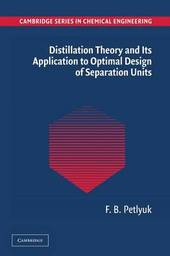
|
Distillation Theory and its Application to Optimal Design of Separation Units
Hardback
Main Details
| Title |
Distillation Theory and its Application to Optimal Design of Separation Units
|
| Authors and Contributors |
By (author) F. B. Petlyuk
|
| Series | Cambridge Series in Chemical Engineering |
|---|
| Physical Properties |
| Format:Hardback | | Pages:362 | | Dimensions(mm): Height 254,Width 178 |
|
| Category/Genre | Biology, life sciences
Biochemical engineering
Industrial chemistry |
|---|
| ISBN/Barcode |
9780521820929
|
| Classifications | Dewey:660.28425 |
|---|
| Audience | | Professional & Vocational | |
|---|
|
Publishing Details |
| Publisher |
Cambridge University Press
|
| Imprint |
Cambridge University Press
|
| Publication Date |
18 October 2004 |
| Publication Country |
United Kingdom
|
Description
Distillation Theory and Its Application to Optimal Design of Separation Units presents a clear, multidimensional geometric representation of distillation theory that is valid for all distillation column types, splits, and mixtures. This representation answers such fundamental questions as: - What are the feasible separation products for a given mixture? - What minimum power is required to separate a given mixture? - What minimum number of trays is necessary to separate a given mixture at a fixed power input? Concepts are reinforced by chapter exercises using free DistillDesigner software, which provides quick and reliable solutions to problems of flowsheet synthesis and to optimal design calculations. This software allows refinement and confirmation of the algorithms of optimal design. This book is intended for students and specialists in the design and operation of separation units in the chemical, pharmaceutical, food, wood, petrochemical, oil-refining, and natural gas industries and for software designers.
Reviews'The book shows a clear, multidimensional, geometric representation of distillation theory, which is applicable to all kinds of distillation columns for all splits, column types and mixtures ... the book considers problems that are beyond the framework of the geometric theory of distillation but they still are of importance from both the theoretical and practical standpoints ... contains many diagrams, which facilitate the understanding of geometry theory ... intended for a wide variety of specialists ...This book can serve as a manual for students and postgraduate who want to refine their understanding of distillation.' Iasi Polytechnic Magazine
|